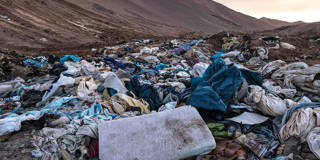While waste-to-energy facilities have been touted as a sustainable response to the escalating production of solid waste worldwide, they are merely the latest in a long line of innovations that address the symptoms rather than the disease. The climate crisis underscores the urgent need to change how waste is produced.
CHICAGO – With world leaders gathered in Dubai for the United Nations Climate Change Conference (COP28), the United Arab Emirates has unveiled the world’s highest-capacity waste-to-energy (WTE) facility. The plant is designed to process two million metric tons of municipal waste annually, producing enough electricity to power 120,000 households per year by incinerating discarded materials. Paradoxically, it is both a cutting-edge innovation and a strategy from the past.
The Dubai facility is one of thousands of WTE projects recently completed, under construction, or planned. Over 2,600 such facilities are currently operational worldwide, including more than 400 in China alone. A recent report projected rapid growth for the WTE industry, with revenues nearly doubling from $27.7 billion in 2021 to roughly $45.2 billion in 2029. That expansion will be largely owed to the global effort to meet the Paris climate agreement’s targets, which has fueled increased investment in sustainable waste-management solutions.
This bodes well for the battle against climate change. WTE facilities currently process more than 400 million tons of waste annually, accounting for roughly 20% of the two billion tons of residual waste remaining each year after reuse, composting, and recycling. Decomposing waste in landfills emits methane, a gas with 28 times the warming potential of carbon dioxide. Redirecting waste materials to WTE facilities helps to reduce methane emissions, as well as conserve land and generate electricity.

CHICAGO – With world leaders gathered in Dubai for the United Nations Climate Change Conference (COP28), the United Arab Emirates has unveiled the world’s highest-capacity waste-to-energy (WTE) facility. The plant is designed to process two million metric tons of municipal waste annually, producing enough electricity to power 120,000 households per year by incinerating discarded materials. Paradoxically, it is both a cutting-edge innovation and a strategy from the past.
The Dubai facility is one of thousands of WTE projects recently completed, under construction, or planned. Over 2,600 such facilities are currently operational worldwide, including more than 400 in China alone. A recent report projected rapid growth for the WTE industry, with revenues nearly doubling from $27.7 billion in 2021 to roughly $45.2 billion in 2029. That expansion will be largely owed to the global effort to meet the Paris climate agreement’s targets, which has fueled increased investment in sustainable waste-management solutions.
This bodes well for the battle against climate change. WTE facilities currently process more than 400 million tons of waste annually, accounting for roughly 20% of the two billion tons of residual waste remaining each year after reuse, composting, and recycling. Decomposing waste in landfills emits methane, a gas with 28 times the warming potential of carbon dioxide. Redirecting waste materials to WTE facilities helps to reduce methane emissions, as well as conserve land and generate electricity.